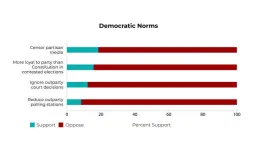(Press-News.org) Research Highlights:
A study of over 20,000 adults found that those who followed an 8-hour time-restricted eating schedule, a type of intermittent fasting, had a 91% higher risk of death from cardiovascular disease.
People with heart disease or cancer also had an increased risk of cardiovascular death.
Compared with a standard schedule of eating across 12-16 hours per day, limiting food intake to less than 8 hours per day was not associated with living longer.
Embargoed until 3 p.m. CT/4 p.m. ET, Monday, March 18, 2024
CHICAGO, March 18, 2024 — An analysis of over 20,000 U.S. adults found that people who limited their eating across less than 8 hours per day, a time-restricted eating plan, were more likely to die from cardiovascular disease compared to people who ate across 12-16 hours per day, according to preliminary research presented at the American Heart Association’s Epidemiology and Prevention│Lifestyle and Cardiometabolic Scientific Sessions 2024, March 18- 21, in Chicago. The meeting offers the latest science on population-based health and wellness and implications for lifestyle.
Time-restricted eating, a type of intermittent fasting, involves limiting the hours for eating to a specific number of hours each day, which may range from a 4- to 12-hour time window in 24 hours. Many people who follow a time-restricted eating diet follow a 16:8 eating schedule, where they eat all their foods in an 8-hour window and fast for the remaining 16 hours each day, the researchers noted. Previous research has found that time-restricted eating improves several cardiometabolic health measures, such as blood pressure, blood glucose and cholesterol levels.
“Restricting daily eating time to a short period, such as 8 hours per day, has gained popularity in recent years as a way to lose weight and improve heart health,” said senior study author Victor Wenze Zhong, Ph.D., a professor and chair of the department of epidemiology and biostatistics at the Shanghai Jiao Tong University School of Medicine in Shanghai, China. “However, the long-term health effects of time-restricted eating, including risk of death from any cause or cardiovascular disease, are unknown.”
In this study, researchers investigated the potential long-term health impact of following an 8-hour time-restricted eating plan. They reviewed information about dietary patterns for participants in the annual 2003-2018 National Health and Nutrition Examination Surveys (NHANES) in comparison to data about people who died in the U.S., from 2003 through December 2019, from the Centers for Disease Control and Prevention’s National Death Index database.
The analysis found:
People who followed a pattern of eating all of their food across less than 8 hours per day had a 91% higher risk of death due to cardiovascular disease.
The increased risk of cardiovascular death was also seen in people living with heart disease or cancer.
Among people with existing cardiovascular disease, an eating duration of no less than 8 but less than 10 hours per day was also associated with a 66% higher risk of death from heart disease or stroke.
Time-restricted eating did not reduce the overall risk of death from any cause.
An eating duration of more than 16 hours per day was associated with a lower risk of cancer mortality among people with cancer.
“We were surprised to find that people who followed an 8-hour, time-restricted eating schedule were more likely to die from cardiovascular disease. Even though this type of diet has been popular due to its potential short-term benefits, our research clearly shows that, compared with a typical eating time range of 12-16 hours per day, a shorter eating duration was not associated with living longer,” Zhong said.
“It’s crucial for patients, particularly those with existing heart conditions or cancer, to be aware of the association between an 8-hour eating window and increased risk of cardiovascular death. Our study’s findings encourage a more cautious, personalized approach to dietary recommendations, ensuring that they are aligned with an individual’s health status and the latest scientific evidence,” he continued. “Although the study identified an association between an 8-hour eating window and cardiovascular death, this does not mean that time-restricted eating caused cardiovascular death.”
Study details and background:
The study included approximately 20,000 adults in the U.S. with an average age of 49 years.
Study participants were followed for a median length of 8 years and maximum length of 17 years.
The study included data for NHANES participants who were at least 20 years old at enrollment, between 2003-2018, and had completed two 24-hour dietary recall questionnaires within the first year of enrollment.
Approximately half of the participants self-identified as men, and half self-identified as women. 73.3% of the participants self-identified as non-Hispanic white adults, 11% self-identified as Hispanic adults, 8% self-identified as non-Hispanic Black adults and 6.9% of adults self-identified as another racial category, including mixed-race adults and adults of other non-Hispanic races.
The study’s limitations included its reliance on self-reported dietary information, which may be affected by participant’s memory or recall and may not accurately assess typical eating patterns. Factors that may also play a role in health, outside of daily duration of eating and cause of death, were not included in the analysis.
Future research may examine the biological mechanisms that underly the associations between a time-restricted eating schedule and adverse cardiovascular outcomes, and whether these findings are similar for people who live in other parts of the world, the authors noted.
“Overall, this study suggests that time-restricted eating may have short-term benefits but long-term adverse effects. When the study is presented in its entirety, it will be interesting and helpful to learn more of the details of the analysis,” said Christopher D. Gardner, Ph.D., FAHA, the Rehnborg Farquhar Professor of Medicine at Stanford University in Stanford, California, and chair of the writing committee for the Association’s 2023 scientific statement, Popular Dietary Patterns: Alignment with American Heart Association 2021 Dietary Guidance.
“One of those details involves the nutrient quality of the diets typical of the different subsets of participants. Without this information, it cannot be determined if nutrient density might be an alternate explanation to the findings that currently focus on the window of time for eating. Second, it needs to be emphasized that categorization into the different windows of time-restricted eating was determined on the basis of just two days of dietary intake,” he said.
“It will also be critical to see a comparison of demographics and baseline characteristics across the groups that were classified into the different time-restricted eating windows – for example, was the group with the shortest time-restricted eating window unique compared to people who followed other eating schedules, in terms of weight, stress, traditional cardiometabolic risk factors or other factors associated with adverse cardiovascular outcomes? This additional information will help to better understand the potential independent contribution of the short time-restricted eating pattern reported in this interesting and provocative abstract.”
Co-authors, their disclosures and funding sources are listed in the abstract.
Statements and conclusions of studies that are presented at the American Heart Association’s scientific meetings are solely those of the study authors and do not necessarily reflect the Association’s policy or position. The Association makes no representation or guarantee as to their accuracy or reliability. Abstracts presented at the Association’s scientific meetings are not peer-reviewed, rather, they are curated by independent review panels and are considered based on the potential to add to the diversity of scientific issues and views discussed at the meeting. The findings are considered preliminary until published as a full manuscript in a peer-reviewed scientific journal.
The Association receives funding primarily from individuals; foundations and corporations (including pharmaceutical, device manufacturers and other companies) also make donations and fund specific Association programs and events. The Association has strict policies to prevent these relationships from influencing the science content. Revenues from pharmaceutical and biotech companies, device manufacturers and health insurance providers and the Association’s overall financial information are here.
Additional Resources:
Multimedia is available on the right column of the release link https://newsroom.heart.org/news/8-hour-time-restricted-eating-linked-to-a-91-higher-risk-of-cardiovascular-death?preview=cdac59c3c907975eecaef517166f08f8
After March 18, 2024, view abstract P192 in the EPI│Lifestyle Scientific Sessions 2024 Online Program Planner.
AHA news release: Reducing total calories may be more effective for weight loss than intermittent fasting (January 2023)
AHA news release: 10 popular diets scored for heart-healthy elements; some need improvement (April 2023)
AHA news release: New look at nutrition research identifies 10 features of a heart-healthy eating pattern (November 2021)
AHA healthy eating tips: Eat Smart
For more news from AHA EPI|Lifestyle Scientific Sessions 2024, follow us on X (formerlTwitter) @HyeartNews, #EPILifestyle24.
###
The American Heart Association’s EPI|Lifestyle Scientific Sessions 2024 is the world’s premier meeting dedicated to the latest advances in population-based science. The 2024 meeting is in-person only, Monday through Thursday, March 18-21 at the Hilton Chicago. The primary goal of the meeting is to promote the development and application of translational and population science to prevent heart disease and stroke and foster cardiovascular health. The sessions focus on risk factors, obesity, nutrition, physical activity, genetics, metabolism, biomarkers, subclinical disease, clinical disease, healthy populations, global health and prevention-oriented clinical trials. The Councils on Epidemiology and Prevention and Lifestyle and Cardiometabolic Health (Lifestyle) jointly planned the EPI|Lifestyle Scientific Sessions 2024. Follow the conference on Twitter at #EPILifestyle24.
About the American Heart Association
The American Heart Association is a relentless force for a world of longer, healthier lives. We are dedicated to ensuring equitable health in all communities. Through collaboration with numerous organizations, and powered by millions of volunteers, we fund innovative research, advocate for the public’s health and share lifesaving resources. The Dallas-based organization has been a leading source of health information for a century. During 2024 - our Centennial year - we celebrate our rich 100-year history and accomplishments. As we forge ahead into our second century of bold discovery and impact, our vision is to advance health and hope for everyone, everywhere. Connect with us on heart.org, Facebook, X or by calling 1-800-AHA-USA1.
END
8-hour time-restricted eating linked to a 91% higher risk of cardiovascular death
American Heart Association Epidemiology and Prevention|Lifestyle and Cardiometabolic Health Scientific Sessions 2024, Abstract P192
2024-03-18
ELSE PRESS RELEASES FROM THIS DATE:
Alternative tidal wetlands in plain sight overlooked Blue Carbon superstars
2024-03-18
Blue Carbon projects are expanding globally; however, demand for credits outweighs the available credits for purchase.
Currently, only three types of wetlands are considered Blue Carbon ecosystems: mangroves, saltmarsh and seagrass.
However, other tidal wetlands also comply with the characteristics of what is considered Blue Carbon, such as tidal freshwater wetlands, transitional forests and brackish marshes.
In a new study, scientists from Australia, Indonesia, Singapore, South Africa, Vietnam, the US and Mexico have highlighted the increasing opportunities for Blue Carbon projects for the conservation, restoration and improved management of highly threatened ...
The majority of Americans do not support anti-democratic behavior, even when elected officials do
2024-03-18
EMBARGOED UNTIL MARCH 18 AT 3 P.M. EST
Recently, fundamental tenets of democracy have come under threat, from attempts to overturn the 2020 election to mass closures of polling places.
A new study from the Polarization Research Lab, a collaboration among researchers at the Annenberg School for Communication at the University of Pennsylvania, Dartmouth College, and Stanford University, has found that despite this surge in anti-democratic behavior by U.S. politicians, the majority of Americans oppose anti-democratic attitudes and reject partisan violence.
From September 2022 to October 2023, a period which included the 2022 midterm ...
Genes identified that allow bacteria to thrive despite toxic heavy metal in soil
2024-03-18
VANCOUVER, Wash. -- Some soil bacteria can acquire sets of genes that enable them to pump the heavy metal nickel out of their systems, a study has found. This enables the bacteria to not only thrive in otherwise toxic soils but help plants grow there as well.
A Washington State University-led research team pinpointed a set of genes in wild soil bacteria that allows them to do this in serpentine soils which have naturally high concentrations of toxic nickel. The genetic discovery, detailed in the journal Proceedings of the National Academies ...
Scientists’ discovery could reduce dependence on animals for vital anti-blood clot drug
2024-03-18
Heparin, the world’s most widely used blood thinner, is used during procedures ranging from kidney dialysis to open heart surgery. Currently, heparin is derived from pig intestines, but scientists at Rensselaer Polytechnic Institute have discovered how to make it in the lab. They have also developed a path to a biomanufacturing process that could potentially revolutionize how the world gets its supply of this crucial medicine.
“In recent years, with disease and contamination issues disrupting the global supply chain of pig heparin and potentially putting millions of patients at risk, it’s clear we need to diversify ...
Artificial streams reveal how drought shapes California’s alpine ecosystems
2024-03-18
Berkeley — A network of artificial streams is teaching scientists how California’s mountain waterways — and the ecosystems that depend on them — may be impacted by a warmer, drier climate.
Over the next century, climate change is projected to bring less snowfall to the Sierra Nevada. Smaller snowpacks, paired with warmer conditions, will shift the annual snowmelt earlier into the year, leaving less water to feed streams and rivers during the hot summer months. By 2100, mountain streams are predicted to reach their annual base, or “low-flow,” conditions an average of six ...
Not in my backyard? Wind turbines have little effect on US property values
2024-03-18
“The impact of wind turbines on house prices is much smaller than generally feared: In the U.S., it’s about one percent for a house that has at least one wind turbine in a 10 km radius”, explains Maximilian Auffhammer, a Professor in the Department of Agricultural and Resource Economics at the University of California, Berkeley and co-author of the study. “And what really surprised me is that the house value bounces back to the original price over the years.” The study authors also found that there was no longer any ...
The costs of a changing landscape
2024-03-18
UNDER EMBARGO UNTIL MARCH 18, 2024 AT 3:00 PM U.S. EASTERN TIME
Renewable energy sources are essential for transitioning towards a decarbonized energy system and making the electricity grid more environmentally sustainable. Clean energy alternatives like wind power can effectively replace fossil fuels, contributing to reduced air pollution and slow down climate change.
Wind power has emerged as the fastest-growing non-hydro renewable energy source worldwide. However, the implementation of wind energy infrastructure, including windmills, faces significant challenges. One major obstacle is the opposition from local communities.
Wind turbines, the primary ...
UMD researchers develop genomic method of monitoring for pesticide resistance
2024-03-18
Farmers rely on pesticides to control agricultural pests. But insects often develop resistance to the toxins in pesticides. University of Maryland researchers have developed and successfully tested a strategy for using genomics to monitor for and identify emerging resistance to specific toxins early, well before it becomes a widespread problem. The work will enable farmers to mitigate resistance and prolong the effectiveness of pest management tools.
The research was published on March 18, 2024, in the Proceedings of ...
Backyard insect inspires invisibility devices, next gen tech
2024-03-18
UNIVERSITY PARK, Pa. — Leafhoppers, a common backyard insect, secrete and coat themselves in tiny mysterious particles that could provide both the inspiration and the instructions for next-generation technology, according to a new study led by Penn State researchers. In a first, the team precisely replicated the complex geometry of these particles, called brochosomes, and elucidated a better understanding of how they absorb both visible and ultraviolet light.
This could allow the development of bioinspired optical materials with possible applications ranging from invisible cloaking devices to coatings to more efficiently harvest ...
Americans support democratic norms, elected officials don't
2024-03-18
Following the attack on the U.S. Capitol on Jan. 6, 2021, and efforts to overturn the results of the 2020 presidential election, many Americans have raised concerns about the future of democracy in the United States.
Yet the American public, including Democrats and Republicans alike, strongly oppose anti-democratic actions and partisan violence, according to a new study by the Polarization Research Lab.
"Democracy is under threat in America, but these data show we are not on the brink of a citizen-supported push toward authoritarianism," says the lab's ...
LAST 30 PRESS RELEASES:
Heart-brain connection: international study reveals the role of the vagus nerve in keeping the heart young
Researchers identify Rb1 as a predictive biomarker for a new therapeutic strategy in some breast cancers
Survey reveals ethical gaps slowing AI adoption in pediatric surgery
Stimulant ADHD medications work differently than thought
AI overestimates how smart people are, according to HSE economists
HSE researchers create genome-wide map of quadruplexes
Scientists boost cell "powerhouses" to burn more calories
Automatic label checking: The missing step in making reliable medical AI
Low daily alcohol intake linked to 50% heightened mouth cancer risk in India
American Meteorological Society announces Rick Spinrad as 2026 President-Elect
Biomass-based carbon capture spotlighted in newly released global climate webinar recording
Illuminating invisible nano pollutants: advanced bioimaging tracks the full journey of emerging nanoscale contaminants in living systems
How does age affect recovery from spinal cord injury?
Novel AI tool offers prognosis for patients with head and neck cancer
Fathers’ microplastic exposure tied to their children’s metabolic problems
Research validates laboratory model for studying high-grade serous ovarian cancer
SIR 2026 delivers transformative breakthroughs in minimally invasive medicine to improve patient care
Stem Cell Reports most downloaded papers of 2025 highlight the breadth and impact of stem cell research
Oxford-led study estimates NHS spends around 3% of its primary and secondary care budget on the health impacts of heat and cold in England
A researcher’s long quest leads to a smart composite breakthrough
Urban wild bees act as “microbial sensors” of city health.
New study finds where you live affects recovery after a hip fracture
Forecasting the impact of fully automated vehicle adoption on US road traffic injuries
Alcohol-related hospitalizations from 2016 to 2022
Semaglutide and hospitalizations in patients with obesity and established cardiovascular disease
Researchers ‘listen in’ to embryo-mother interactions during implantation using a culture system replicating the womb lining
How changing your diet could help save the world
How to make AI truly scalable and reliable for real-time traffic assignment?
Beyond fragmented markets: A new framework for efficient and stable ride-pooling
Can shape priors make road perception more reliable for autonomous driving?
[Press-News.org] 8-hour time-restricted eating linked to a 91% higher risk of cardiovascular deathAmerican Heart Association Epidemiology and Prevention|Lifestyle and Cardiometabolic Health Scientific Sessions 2024, Abstract P192



